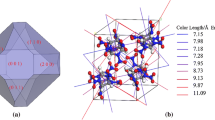Abstract
The spiral growth model was applied to predict the crystal morphology of 2,2′,4,4′,6,6′-hexanitrostilbene (HNS). We selected solvents of N,N-dimethylformamide (DMF), N-methyl pyrrolidone (NMP), and nitric acid (NA) to control the crystal morphologies of HNS. Molecular dynamic simulations were used to relax the constructed interface model. The relative growth rate of important face is calculated by the spiral growth expression. The predicted crystal shapes are flaky in three solvents. Only (100), (001), and (011) faces are generated in DMF, NMP, and NA. The aspect ratios of the predicted HNS crystal morphologies in DMF, NMP, and NA are 23.00, 15.45, and 4.85, respectively. In addition, we analyzed the properties on each face using periodic bond chain, molecular arrangement, and roughness model. The excellent agreement between the predicted morphologies and the experimental images is clearly evident. These simulation results can provide guidance for the recrystallization of HNS.

Graphical abstract









Similar content being viewed by others
References
Bennema P, van Eerden JP (1977) Morphology of crystals. Terra Scientific Publishing Co., Tokyo, pp 1–75
Sangwal K, Zdyb A, Chocyk D et al (1996) Effect of supersaturation and temperature on the growth morphology of ammonium oxalate monohydrate crystals obtained from aqueous solutions. Cryst Res Technol 31:267–273
Karunanithi AT, Achenie LEK, Gani R (2006) A computer-aided molecular design framework for crystallization solvent design. Chem Eng Sci:611247–611260
Vanishri S, Brahadeeswaran S, Bhat HL (2005) Crystal growth of semiorganic sodium p-nitrophenolate dihydrate from aqueous solution and their characterization. J Cryst Growth 275:141–146
Khanam T, Darakis E, Rajendran A et al (2008) On-line digital holographic measurement of size and shape of microparticles for crystallization processes. Proc SPIE-Int Soc Opt Eng 7155:325–332
Winn D, Doherty MF (2010) ChemInform abstract: modeling crystal shapes of organic materials grown from solution. Cheminform 32:1348–1367
Dimo K (2000) Nucleation: basic theory with applications. Butterworths-Heinemann, Oxford
Vainshtein BK, Chernov AA, Shuvalov LA (1984) Modern Crystallography III Crystal Growth, Springer-Verlag
Hartman P, Perdok WG (1955) On the relations between structure and morphology of crystals. I. Acta Crystallogr 8(1):49–52
Docherty R, Clydesdale G, Roberts KJ et al (1991) Application of Bravais-Friedel-Donnay-Harker, attachment energy and Ising models to predicting and understanding the morphology of molecular crystals. J Phys D Appl Phys 24(2):89
Liu XY, Boek ES, Briels WJ et al (1995) Prediction of crystal growth morphology based on structural analysis of the solid–fluid interface. Nature 374(6520):342–345
Burton WK, Cabrera N, Frank FC (1951) The growth of crystals and the equilibrium structure of their surfaces. Phil Trans R Soc A 243(866):299–358
Horst JH, Geertman RM, van Rosmalen GM (2001) The effect of solvent on crystal morphology. J Cryst Growth 230:277–284
Hou L, Zhang C, Li L et al (2018) CO gas sensors based on p-type CuO nanotubes and CuO nanocubes: morphology and surface structure effects on the sensing performance. Talanta 188:41–49
Singh B, Malhotra RK (1983) Hexanitrostilbene and its properties. Def Sci J 33(2):165–176
Quinlin WT (1977) Cyclic recrystallization of Sandia furnished HNS I. Mason and Hanger-Silas Mason Co., Inc., Amarillo
Quinlin WT, Evans VH, Schaffer CL et al (1976) HNS II pilot scale studies and production trial run. Mason and Hanger-Silas Mason Co., Inc., Amarillo
Chen L, Song L, Gao Y et al (2017) Experimental determination of solubilities and supersolubilities of 2,2′,4,4′,6,6′-hexanitrostilbene in different organic solvents. Chin J Chem Eng 25(6):809–814
Chen L, Zhang T, Li M et al (2016) Solubility of 2,2′,4,4′,6,6′-hexa-nitrostilbene in binary solvent of N,N-dimethylformamide and acetonitrile. J Chem Thermodynamics 95:99–104
Singh MK, Tiwari VS (2015) Uncovering the mode of action of solvent and additive controlled crystallization of urea crystal: a molecular-scale study. Cryst Growth Des 15(7):3220–3234
Singh MKA, Banerjee A (2013) Role of solvent and external growth environments to determine growth morphology of molecular crystals. Cryst Growth Des 13(6):2413–2425
Sheremetev AB, Ivanova EA, Spiridonova NP et al (2005) Desilylative nitration of C,N-disilylated 3-amino-4-methylfurazan. J Heterocyclic Chem 42(6):1237–1242
Sun H (1998) COMPASS: an ab initio force-field optimized for condensed-phase applications overview with details on alkane and benzene compounds. J Phys Chem B 102:7338–7364
Materials Studio 5.5 (2007) Acceryls Inc., San Diego
Ewald PP (1921) Die Berechnung optischer und elektrostatischer Gitterpotentiale. Ann Phys 369:253–287
Andersen HC (1980) Molecular dynamics simulations at constant pressure and/or temperature. J Chem Phys 72:2384–2393
Acknowledgments
L. Song thanks the Innovation Postgraduate Research & Practice Innovation Program of Jiangsu Province for supporting this work.
Funding
This work was supported by Guangdong Provincial Key Laboratory of Computational Science and Material Design (No. 2019B030301001) and Guangdong Innovation Research Team Project (No. 2017ZT07C062).
Author information
Authors and Affiliations
Corresponding author
Additional information
Publisher’s note
Springer Nature remains neutral with regard to jurisdictional claims in published maps and institutional affiliations.
Rights and permissions
About this article
Cite this article
Song, L., Zhao, FQ., Xu, SY. et al. Crystal morphology prediction of 2,2′,4,4′,6,6’-hexanitrostilbene (HNS) by molecular scale simulation. J Mol Model 26, 213 (2020). https://doi.org/10.1007/s00894-020-04474-6
Received:
Accepted:
Published:
DOI: https://doi.org/10.1007/s00894-020-04474-6




